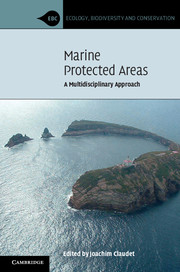Book contents
- Frontmatter
- Contents
- Contributors
- Introduction
- Part I Threats to marine ecosystems and resources
- Part II Effects of marine protected areas
- Part III Assessment of the effectiveness of marine protected areas
- Part IV Scale-up of marine protected area systems
- 11 NETWORKS – The assessment of marine reserve networks: guidelines for ecological evaluation
- 12 CONNECTIVITY – Spacing a network of marine protected areas based on connectivity data
- 13 REPRESENTATIVENESS – Effectiveness of the global network of marine protected areas
- 14 MISSING DIMENSION – Conserving the largest habitat on Earth: protected areas in the pelagic ocean
- Index
- References
11 - NETWORKS – The assessment of marine reserve networks: guidelines for ecological evaluation
from Part IV - Scale-up of marine protected area systems
Published online by Cambridge University Press: 05 August 2012
- Frontmatter
- Contents
- Contributors
- Introduction
- Part I Threats to marine ecosystems and resources
- Part II Effects of marine protected areas
- Part III Assessment of the effectiveness of marine protected areas
- Part IV Scale-up of marine protected area systems
- 11 NETWORKS – The assessment of marine reserve networks: guidelines for ecological evaluation
- 12 CONNECTIVITY – Spacing a network of marine protected areas based on connectivity data
- 13 REPRESENTATIVENESS – Effectiveness of the global network of marine protected areas
- 14 MISSING DIMENSION – Conserving the largest habitat on Earth: protected areas in the pelagic ocean
- Index
- References
Summary
Introduction
As marine ecosystems are plagued by an ever-increasing suite of threats including climate change, pollution, habitat degradation, and fisheries impacts (Roessig et al., 2004; Lotze et al., 2006; Jackson, 2008), there are now no ocean areas that are exempt from anthropogenic impacts (Halpern et al., 2008). In order to preserve marine biodiversity, ecosystem function, and the goods and services provided by resistant and/or resilient systems, marine reserves have been increasingly recommended as part of an ecosystem-based approach to management (Browman and Stergiou, 2004; Levin et al., 2009). Marine reserves are defined as “areas of the ocean completely protected from all extractive and destructive activities” (Lubchenco et al., 2003) and can be experimental controls for evaluating the impact of these activities on marine ecosystems. Growing scientific information has shown consistent increases in species density, biomass, size, and diversity in response to full protection inside reserves of varying sizes and ages located in diverse regions (Claudet et al., 2008; Lester et al., 2009; Molloy et al., 2009). However, most of these data are from individual marine reserves and therefore have inherently limited transferability to networks of marine reserves, which when properly designed can outperform single marine reserves for a variety of ecological, economic, and social management goals (Roberts et al., 2003; Almany et al., 2009; Gaines et al., 2010).
The concept of marine reserve networks grew out of a desire to achieve both conservation and fishery management goals by minimizing the potential negative economic, social, and cultural impacts of a single large reserve while still producing similar or even greater ecological and economic returns (Murray et al., 1999; Gaines et al., 2010). In addition, reserves networks can provide insurance by protecting areas across a region and spreading the risk that these sites may be impacted by localized catastrophes such as hurricanes or oil spills (Allison et al., 2003). The World Conservation Union's Marine Programme defines a network as “a collection of individual marine protected areas (MPAs) or reserves operating co-operatively and synergistically, at various spatial scales and with a range of protection levels that are designed to meet objectives that a single reserve cannot achieve” (IUCN–WCPA, 2008). However, general terms such as “co-operatively” and “synergistically” can have myriad meanings. Without a clear definition of a network, it becomes difficult to identify attainable management goals and design a process for evaluating whether the network achieves those goals. Besides, different management goals may in turn result in the need for different types of networks. The use of MPAs with varying protection levels together with no-take zones in multiple-zoning schemes adds another layer of complexity to network design and evaluation; however, partially protected areas are generally used to manage coastal uses and avoid conflicts (rather than for strict ecological purposes) and are therefore a function of the local social, economic, and cultural context. As we are here interested in the ecological effects of networks, for the purposes of this chapter, we focus on marine reserves because these areas are no-take and therefore offer greater ecological benefits than other types of MPAs that allow some forms of extraction (Lester and Halpern, 2008).
- Type
- Chapter
- Information
- Marine Protected AreasA Multidisciplinary Approach, pp. 293 - 321Publisher: Cambridge University PressPrint publication year: 2011
References
- 8
- Cited by



